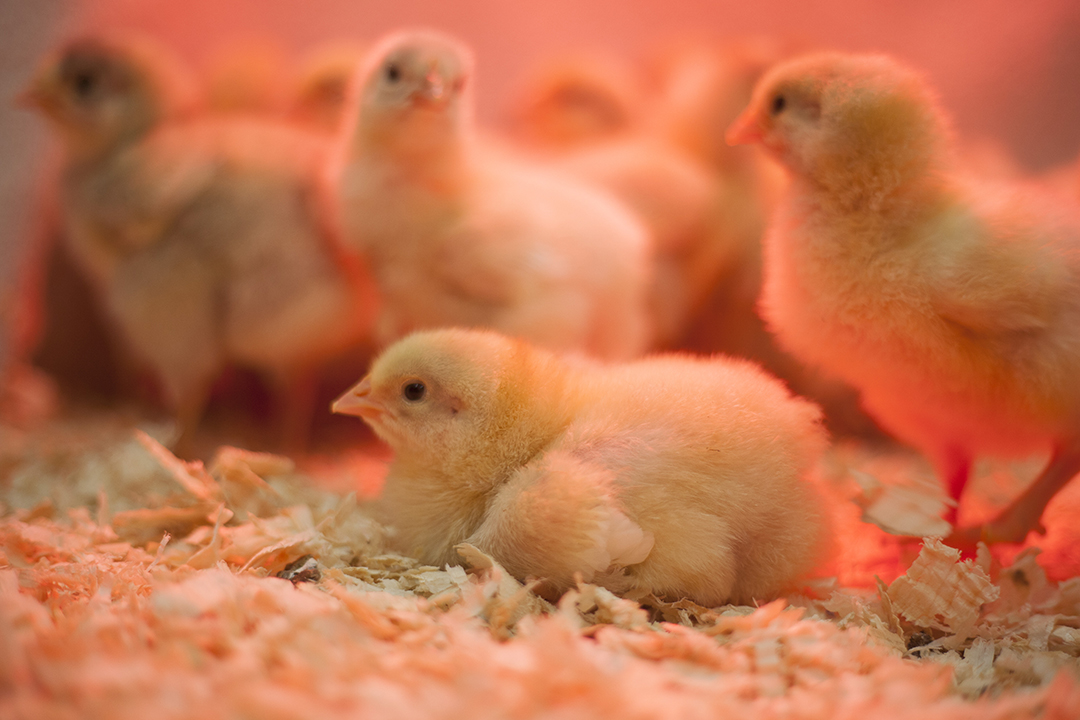
USask team’s aerosol vaccine protects poultry from fatal bacterial disease
A University of Saskatchewan (USask) research team has developed an aerosol vaccine that is proving effective in protecting young broiler chicks against necrotic enteritis, a deadly disease in poultry and a One Health issue affecting both animals and humans.
By Cat Zens
The bacterial disease is caused by the intestinal overgrowth of Clostridium perfringens type G in poultry, contributing to a 50 per cent fatality rate among affected chickens and numerous food poisoning cases in people. Humans can become ill after consuming contaminated and undercooked chicken meat.
“[This disease] is basically re-emerging right now because of less use of antibiotics in the poultry industry,” says Dr. Hemlata Gautam (BVSc&AH), a PhD candidate based in the Department of Veterinary Pathology at the Western College of Veterinary Medicine (WCVM).
Gautam, who works under the supervision of WCVM professor and poultry specialist Dr. Susantha Gomis (BVSc, PhD), is investigating alternative strategies to control and prevent the spread of necrotic enteritis without antibiotic drugs. While antibiotics have been instrumental in preventing this illness and other bacterial diseases in the past, Canada’s poultry industry is phasing out the prophylactic use of antibiotic drugs in broiler chicken production due to overuse and the spread of antimicrobial resistance.
“Unfortunately, there is no effective control against this disease as of now, so … scientists are working toward finding a preventive strategy. In my research, we have developed a vaccination strategy to prevent this disease,” Gautam says.
Timing is everything in Gautam’s research. Chickens have vulnerable immune systems due to their young ages and maternal antibodies only protect them for a couple of weeks after hatching so “we have to make chickens strong enough to fight infection by the third week [of their lives],” says Gautam.
But the WCVM research team’s protective activities begin even earlier in the chickens’ lives. In Gautam’s study, she injected synthetic DNA into chicken eggs around three days before hatching to help activate the birds’ immune systems. The process stimulates the lungs of the embryos, allowing them to recognize live bacteria more quickly and produce an immune response in the gut.
Basically, we used the concept of mucosal vaccination (via the chick’s lung mucosa) and relied on the link between the lungs and the gut — known as the gut-lung axis — to deliver the vaccine,” says Gautam.
A few days later, researchers placed the newly hatched chicks in a special nebulizer chamber where they received a single dose of a live, aerosol vaccine through the lungs — a simpler, less laborious vaccination process for treating chickens.
When the chicks turned three weeks old, Gautam exposed them to Clostridium perfringens for three days to determine if they would develop necrotic enteritis.
In unprotected chicks, the bacterium typically grows unchecked and produces toxins that destroy the inner layer of the bird’s intestines. But in the vaccinated birds, Gautam discovered that the chicks’ intestines were completely healthy even after being exposed to the bacterium — proving that the live vaccine had been effective.
“What we have found is just by giving [chicks] one single vaccine dose by the lungs, we are able to protect them against necrotic enteritis,” she says.
Gautam points out that her research team’s necrotic enteritis vaccine has only been used in experimental trials: “To say completely how it will work in field conditions, we’ll have to do some field trials [in the future].”
In addition to Gautam’s necrotic enteritis vaccine research, Gomis’s research team is also working on improving diagnostic tests for chickens by analyzing molecules in their fecal samples. Results from this research may eventually allow scientists to use blood samples from live birds to determine if they have necrotic enteritis or other infectious diseases.
Now that Gautam and her research colleagues have confirmed that their aerosol vaccine is effective against necrotic enteritis, she says that a similar vaccination strategy may help to fight other infectious diseases in poultry. As well, her team’s research work may contribute to further studies on administering vaccines through the lungs in humans and other animals.
“It’s a growing area right now — how we can give vaccines in the lungs and how it can protect different areas of the intestine,” she says. “This [vaccination] strategy might be helpful for other infectious diseases as well [in other species] and definitely in the poultry industry.”
This research project is financially supported by the Canadian Poultry Research Council as part of Canada’s Poultry Science Cluster, Agriculture and Agri-Food Canada, and the Chicken Farmers of Saskatchewan.
Cat Zens of North Battleford, Sask., worked as a research communications intern at the Western College of Veterinary Medicine (WCVM) in 2023.
Together, we will undertake the research the world needs. We invite you to join by supporting critical research at USask.
